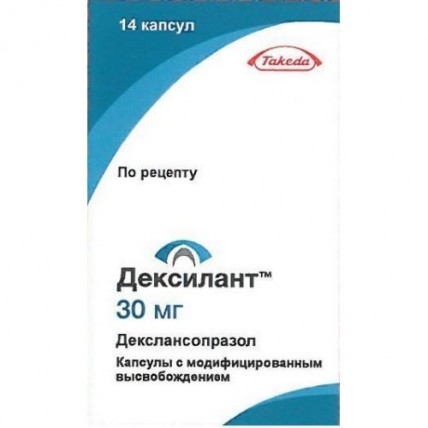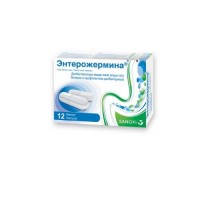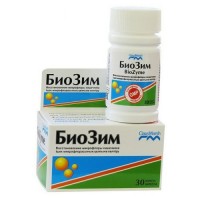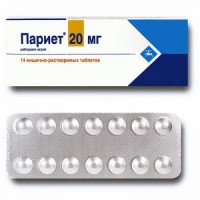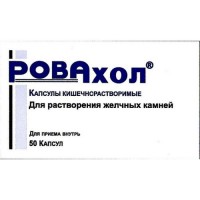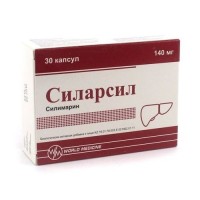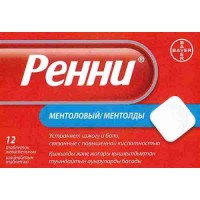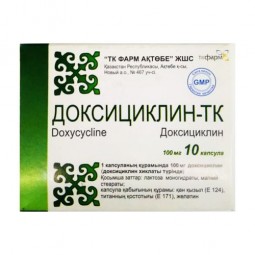Dexilant 14s 30 mg modified-release capsules
- $35.90
The instruction for medical use of Deksilant™ medicine the Trade name of Deksilant™ the International unlicensed name Dekslansoprazol Lekarstvennaya the Capsule form with the modified release of 30 mg and 60 mg Structure One capsule contains active agents: dekslansoprazol 30 mg or 60 mg excipients: sugar krupka, magnesium a carbonate, the sucrose, a hypro rod low-substituted, a hypro rod, a gipromelloza 2910, talc, the titan dioxide (E 171), dispersion of methacrylic acid of copolymer, a macrogoal 8000, polysorbate 80, silicon dioxide colloidal anhydrous, methacrylic acid copolymer (type B), methacrylic acid copolymer (type A), triethyl citrate a capsule Cover: Carrageenan, potassium chloride, the titan dioxide (E 171), FD & C dye blue No. 2 aluminum varnish (E132), ferrous oxide black (E 172), the gipromelloza, blackened the gray cleaned - structure of a sugar krupka: sucrose, starch corn, ** - structure of dispersion of methacrylic acid of copolymer: methacrylic acid, ethyl acrylate, sodium lauryl sulfate, polysorbate, *** - the structure blackened gray cleaned: ferrous oxide red (E 172), ferrous oxide yellow (E 172), FD & C dye blue No. 2 aluminum varnish (E 132), wax of karnaubskiya, shellac, glycerin monooleate. The description of the Capsule with an opaque blue lid and with the opaque gray body. On a lid dark gray ink applied the TAR logo, on the body – the inscription 30. Contents of capsules - granules from white till almost white color (for a dosage of 30 mg) Capsules with an opaque blue lid and the body. On a lid dark gray ink applied the TAR logo, on the body - the inscription 60. Contents of capsules - granules from white till almost white color (for a dosage of 60 mg) Pharmacotherapeutic group Drugs for treatment of a disease connected with disturbance of acidity. Antiulcerous drugs and drugs for treatment of a gastroesophageal reflux. Inhibitors of the protonew pump. Dekslansoprazol. The ATX A02BC06 code the Pharmacological Pharmacokinetics of Deksilant™ properties – drug the first peak happens to the double slowed-down release of medicinal substance which leads to two various peaks of concentration in blood plasma within one-two hours after intake, then the second peak within four-five hours follows. About one-two hours healthy people and at patients with symptoms of a gastroesophageal reflux disease have a half-life period of a dekslansoprazol (GERD). Accumulation of a dekslansoprazol after repeated and one-time administration of drug of Дексилант™ 30 mg or 60 mg does not happen though average values of the area under curve (AUCt) and the maximum concentration of medicine reached in plasma (Cmax) of a dekslansoprazol were slightly higher (less than 10%) for the 5th day, than for the 1st day. The pharmacokinetics of a dekslansoprazol is very variable, with values of percentage coefficient of variation (CV %) for Cmax, AUC, and clearance at oral administration of drug (CL/F) more than 30% of percent (you watch table 1). Table 1: Average values (CV %) of pharmacokinetic parameters at patients for 5 day after administration of drug of Deksilant of TM the Dose (mg) of Cmax (ng/ml) of AUC24 (ng · h/ml) CL/F (l/h) 30,658 (40%) (N=44) 3275 (47%) (N=43) 11.4 (48%) (N=43) 60 of 1397 (51%) (N=79) 6529 (60%) (N=73) 11.6 (46%) (N=41) Absorption After oral administration of 30 mg or 60 mg of the drug Deksilant™ by healthy faces and patients from symptomatic GERD, average Cmax and AUC values of a dekslansoprazol increased approximately in proportion to a dose. When drug Deksilant™ granules in a dose of 60 mg mix with water and enter via the nazogastralny probe or orally via the syringe, bioavailability (Cmax and AUC) a dekslansoprazola is similar to bioavailability at administration of drug Дексилант™ 60 of mg in the form of not opened capsule. Distribution Linking of a dekslansoprazol with proteins of plasma at healthy volunteers fluctuated from 96% to 99% and was independent in concentration of 0.01-20 mkg/l. At patients with a symptomatic gastroesophageal reflux disease the obvious volume of distribution (Vz/F) after reception of repeated doses was 40 l. Metabolism Dekslansoprazol is extensively metabolized in a liver by oxidation, restoration and the subsequent formation of sulphatic, glyukuronidny and glutationovy connections to inactive metabolites. Oxidizing metabolites are formed by means of the fermental system of P450 cytochrome (CYP), including hydroxylation, mainly by an isoenzyme of CYP2C19 and oxidation to sulphone CYP3A4 isoenzyme. The isoenzyme of CYP2C19 is a polymorphic hepatic isoenzyme which shows three phenotypes at metabolism of CYP2C19 substrates, fast metabolizator (*1/*1), intermediate metabolizator (*1/mutants) and slow metabolizator (mutant/mutant). Dekslansoprazol is the main component circulating in plasma irrespective of the status of CYP2C19 of a metabolizator. At intermediate and fast metabolizator of an isoenzyme of CYP2C19, the main metabolite in blood plasma is 5-hydroksidekslansoprazol and its glucuronic connection while at slow metabolizator of CYP2C19 sulphone is the main metabolite in blood plasma. Discharge After administration of the drug Deksilant™ dekslansoprazol is not removed in not changed view with urine. After introduction of a dekslansoprazol, to marked 14C, six healthy volunteers, about 50.7% (the standard deviation (SD): 9.0%) the entered radioactivity were removed with urine and 47.6% (SD: 7.3%) – with a stake. The clearance at oral administration by healthy faces was 11.4-11.6 l/h respectively after 5-day use in doses of 30 mg or 60 mg once a day. Influence of meal In researches on influence of meal with healthy volunteers, administration of drug of Deksilant™ after a meal was compared to administration of drug on a hungry stomach, increase in Cmax fluctuated from 12% to 55%, increase in AUC fluctuated from 9% to 37%, and Tmax also changed (ranging from decrease to 0.7 h to increase till three o'clock). Special groups of patients Children's age Pharmacokinetics of a dekslansoprazol at patients aged up to 18 years were not studied. Advanced age At elderly in comparison with young people considerably increases final elimination half-life (2.2 and 1.5 hours respectively). System impact (AUC) of a dekslansoprazol on elderly is much higher, than at young patients (34% are higher). Paul Pri reception of a single oral dose of drug Дексилант™ 60 of mg by 12 healthy men and 12 healthy women, at women was revealed higher level of system influence (AUC) (43% higher), than at men. This difference does not represent a considerable problem on safety. The renal failure Dekslansoprazol is substantially metabolized in a liver to inactive metabolites, and after oral administration of a dekslansoprazol initial substance in urine is not found. Therefore it is not expected that the pharmacokinetics of a dekslansoprazol will change at patients with renal failures. Researches among patients from impaired renal function were not conducted. Besides, the pharmacokinetics of a lansoprazol clinically did not differ at patients with renal failures of easy, moderate and heavy degree in comparison with healthy faces with normal function of kidneys. An abnormal liver function At 12 patients with moderate abnormal liver functions (class B on a scale of Chayld-Pyyu) who received a single oral dose of 60 mg of the drug Deksilant™, system influence (AUC) of the connected and untied dekslansoprazol was approximately twice more, than at patients with normal function of a liver. This difference in influence was not owing to a difference in linking with proteins. Researches at patients with heavy abnormal liver functions were not conducted. The pharmacodynamics the action Mechanism Dekslansoprazol belongs to the class of anti-secretory drugs, is derivative benzimidazole which suppresses secretion of gastric juice by oppression of N +/K+-ATF-azy in covering cells of a stomach. As this enzyme is considered as acid (-proton) the pump in covering cells, dekslansoprazol is characterized as inhibitor of the proton pump of a stomach as it blocks a final stage of a kislotoobrazovaniye. Anti-secretory activity In a cross research with healthy subjects the anti-secretory influence on 24-hour intragastric pH at administration of drugs of Дексилант™ 60 mg (n = 20) and lansoprazol 30 mg (n = 23) once a day within five days was estimated. Results are given in table 2. Table 2. Influence on 24-hour intragastric rn for the 5th day of administration of drugs of Deksilant™ and lansoprazol Дексилант™ 60 mg Lansoprazol of 30 mg Average value of intragastric pH 4.55 4.13 the Period with level intragastric rn & gt, 4, % (hours) 71 (17 hours) 60 (14 hours) Influence on the level of serumal gastrin Influence of the drug Deksilant™ on concentration of serumal gastrin was estimated approximately at 3460 patients in clinical trials by duration up to eight weeks, and at 1023 patients lasting from six to 12 months. The average value of concentration of gastrin on an empty stomach increased in comparison with control group during Дексилант™ 30 drug treatment of mg and 60 mg. At the patients receiving treatment within more than six months, the average levels of serumal gastrin increased approximately within the first three months of treatment, and were stable during the remained treatment time. The average levels of serumal gastrin returned to levels before treatment within one month after a prekrashcheniyapriyem of drug. Increase in gastrin causes a hyperplasia of enterokhromaffinopodobny cells (ECL) and level of serumal chromogranin A (CgA). Increase in the CgA level can cause false positive results in diagnostic inspections concerning neuroendocrinal tumors. Influence on enterokhromaffinopodobny cells (ECL) At use of Дексилант™ 30 mg, 60 mg or 90 mg during the period up to 12 months of messages about a hyperplasia of ECL cells on the basis of gastrobioptat was not received. At use the rats of a lansoprazol up to 150 mg/kg/day during all life observed development of a gipergastrinemiya with the subsequent proliferation of cells of ECL and forming of carcinoid tumors, in particular at female individuals. Influence on warm repolarization At reception of a dose five times exceeding the maximum recommended dosage, dekslansoprazol does not extend QT interval to any clinically significant values. Indications treatment of an erosive esophagitis of any severity, maintenance therapy of the treated erosive esophagitis and simplification of manifestations of heartburn, for treatment of the heartburn connected with a symptomatic not erosive gastroesophageal reflux disease (GERD) the Route of administration and doses Important information on use the Passed doses: if the dose is passed, it is necessary to accept the capsule as soon as possible. However, if it is already necessary to accept the following planned dose, do not accept passed, and accept the following dose in time. It is impossible to accept two doses at the same time for the purpose of compensation of the passed dose. Дексилант™ it is possible to accept regardless of meal. To swallow entirely, not to chew. Patients with disturbance of swallowing can open capsules of the drug Deksilant™ and to accept with apple puree as follows: 1. Place one tablespoon of apple puree in net capacity. 2. Open the capsule. 3. Pour out granules in apple puree. 4. Immediately swallow apple puree with granules. Not to chew a granule. You do not store apple puree with granules for the subsequent use. As an alternative, capsules can be entered with water, by means of the oral syringe or via the nazogastralny probe. Introduction with water by means of oral syringe 1. Open the capsule and pour out granules in net capacity from 20 ml of water. 2. Place all mix in the syringe. 3. Accurately mix syringe contents for prevention of sedimentation of granules. 4. Immediately enter mix into a mouth. You do not store mix of water and granules for the subsequent use. 5. Repeatedly fill the syringe of 10 ml of water, carefully shake up and enter into a mouth. 6. Again repeatedly fill the syringe of 10 ml of water, carefully shake up and enter into a mouth. Introduction with water via the nazogastralny probe (& gt, 16 French calibers) 1. Open the capsule and pour out granules in net capacity from 20 ml of water. 2. Place all mix in the syringe with a catheter on the end. 7. Accurately mix syringe contents for prevention of sedimentation of granules and immediately enter mix into a stomach via the nazogastralny probe. You do not store mix of water and granules for the subsequent use. 3. Repeatedly fill the syringe of 10 ml of water, carefully shake up and pour in the probe. 4. Again fill the syringe of 10 ml of water, carefully shake up and enter into a stomach. Дексилант™ it is available in the form of capsules in doses 30 mg and 60 mg. Recommendations about doses for adults are provided in table 3. Table 3. Дексилант™ Recommendations about dosing at adults the Indication the Recommended dose Frequency Treatment of an erosive esophagitis of 60 mg Once a day, up to 8 weeks the Maintenance therapy of the treated erosive esophagitis and simplification of manifestations of heartburn of 30 mg Once a day *, up to 6 months Symptomatic not erosive GERD of 30 mg Once a day, up to 4 weeks * Controlled researches lasted no more than 6 months Dose adjustment at adult patients with an erosive esophagitis and disturbances of functions of a liver At patients with abnormal liver functions of moderate severity (class B on a scale of Chayld-Pyyu) a daily dose should not exceed 30 mg of a dekslansoprazol up to 8 weeks once a day. Use of the drug Deksilant™ is not recommended at patients with abnormal liver functions of heavy degree (class C on a scale of Chayld-Pyyu). Side effects the Following serious side reactions are described below and also in other sections of the instruction: Acute interstitial nephrite Deficiency of cyanocobalamine (B12 vitamin) Klostridialnaya diarrhea the Bone fracture the Hypomagnesiemia Experience of clinical trials As clinical trials are carried out under different conditions, the share of the adverse reactions observed during their carrying out cannot be compared directly to a share of reactions in clinical trials with other drug. Besides, they can not reflect the frequency revealed in practice. Safety of the drug Deksilant™ was estimated at 4548 patients in controlled and uncontrollable clinical trials, including at 863 patients receiving treatment within, at least, six months and at 203 patients receiving treatment within one year. Patients aged from 18 up to 90 years (average age of 48 years), 54% of women, 85% of Caucasians, 8% of black, 4% of Asians and 3% of other races participated in researches. Six randomized controlled clinical trials were carried out concerning treatment of an erosive esophagitis, maintenance therapy of the treated erosive esophagitis and symptomatic GERD. They included 896 patients receiving placebo, 455 patients receiving Дексилант™ 30 mg, 2218 patients – 60 mg and 1363 patients receiving lansoprazol 30 mg once a day. The most frequent (not less than 2%) undesirable side reactions are diarrhea, a meteorism, an abdominal pain, nausea, vomiting, upper respiratory tract infections. The side reactions leading to cancellation of therapy In controlled clinical trials by the most widespread reaction leading to the termination of administration of drug of Deksilant™ there was diarrhea (0.7%). Less frequent side reactions Other side reactions about which it was reported in controlled researches with a frequency of emergence less than 2% are listed below on the systems of an organism: Disturbances of blood and lymphatic system: anemia, the Disturbance lymphadenopathy from heart: stenocardia, arrhythmia, bradycardia, a stethalgia, hypostasis, a myocardial infarction, heartbeat, Disturbance tachycardia from an organ of hearing and balance: ear pain, sonitus, Disturbance dizziness from an endocrine system: the Disturbance craw from an organ of sight: irritation of eyes, a Disturbance eye from digestive tract swelled: unpleasant feelings in a stomach, sensitivity in a stomach, the abnormal chair, anal discomfort, Barret's gullet, a bezoar, abnormal sounds in intestines, began to smell at breath, microscopic colitis, a polyp of a large intestine, a constipation, dryness in a mouth, a duodenitis, dyspepsia, a dysphagy, enteritis, an eructation, an esophagitis, a gastric polyp, Gust
it, a gastroenteritis, gastrointestinal disorders, gastrointestinal hyperkinetic disorders, GERD, ulcers of a GIT and a perforation, a hematemesis, bloody stools, hemorrhoids, gastric emptying disturbance, a syndrome of the angry intestines, a mucous chair, formation of bubbles on a mucous membrane of a mouth, painful defecation, a proctitis, oral cavity paresthesia, rectal hemorrhage, desires to vomiting the General disturbances and disturbances in the injection site: undesirable reaction to medicine, an asthenia, a stethalgia, a fever, abnormal touch, inflammation, inflammation of mucous membranes, a nodule, pain, the Disturbance hyperthermia from a liver and biliary tract: bilious gripes, a cholelithiasis, the Disturbance hepatomegalia from the immune system: hypersensitivity Infectious and parasitic diseases: candidiasis, flu, nasopharyngitis, oral herpes, pharyngitis, sinusitis, viral infection, vulvovaginal infections of the Injury, poisoning and complication of procedures: falling, fractures, dislocations of joints, overdose, pain during the procedure, a sunblister Laboratory researches: increase in level alkaline phosphotazy, increase in level of alaninaminotranspherase (ALT), increase in aspartate aminotransferase (nuclear heating plant), the increased/lowered bilirubin, the increased blood creatinine, the increased blood gastrin, the increased glucose level in blood, the increased potassium in the blood deviating norm hepatic tests, the reduced quantity of thrombocytes, increase in crude protein, increase in weight of Disturbance from a metabolism and food: change of appetite, a hypercalcemia, the Disturbance hypopotassemia from skeletal muscles and connective tissue: an arthralgia, arthritis, muscular spasms, skeletal and muscular pain, Disturbance myalgia from nervous system: change of flavoring feelings, spasms, dizziness, headaches, migraine, memory impairment, paresthesia, psychomotor hyperactivity, tremor, epileptiform neuralgia of Disturbance of mentality: unusual dreams, alarm, a depression, insomnia, changes of a libido of Disturbance from kidneys and urinary tract: a dysuria, imperative desires to urination of Disturbance from a reproductive system and a mammary gland: a dysmenorrhea, a dispareuniya, a menorrhagia, disturbance of a menstrual cycle of Disturbance from respiratory organs, a thorax and mediastinum: aspiration, asthma, bronchitis, cough, short wind, a hiccups, a hyperventilation, congestion of airways, the Disturbance sore throat from skin and hypodermic cellulose: acne, dermatitis, erythema, itching, rash, damage of skin, urticaria Disturbance of activity of a cardiovascular system: the deep vein thrombosis, inflows, a hypertension included Additional side reactions about which it was reported in a long-term uncontrollable research and which, according to the attending physician, were connected with administration of drug of Deksilant™: anaphylaxis, auditory hallucinations, V-cellular lymphoma, bursitis, central obesity, acute cholecystitis, dehydration, diabetes, dysphonia, epistaxis, folliculitis, gout, shingles, lipidemia, hypothyroidism, increase in quantity of neutrophils, decrease in average concentration of hemoglobin in erythrocytes, a neutropenia, painful desires to defecation, restless legs syndrome, drowsiness, tonsillitis. Experience of post-registration use the Following side reactions were revealed in the course of post-registration use of the drug Deksilant™. As about these reactions it was reported in a voluntary form from the population in uncertain volume, it is not always possible to estimate authentically the frequency of their manifestation, or to establish relationship of cause and effect with drug influence. Disturbances of blood and lymphatic system: autoimmune hemolytic anemia, an idiopathic Werlhof's disease of Disturbance from an organ of hearing and balance: Disturbance deafness from an organ of sight: illegibility of sight of Disturbance from digestive tract: oral cavity hypostasis, pancreatitis the General disturbances and disturbances in the injection site: the Disturbance face edema from a liver and biliary tract: medicamentous hepatitis of Disturbance from the immune system: the acute anaphylaxis (demanding the emergency intervention), exfoliative dermatitis, Stephens-Johnson's syndrome, a toxic epidermal necrolysis (sometimes from the death) Infectious and parasitic diseases: klostridialny diarrhea of Disturbance from a metabolism and food: hypomagnesiemia, hyponatremia of the Musculoskeletal disorder: the Disturbance bone fracture from nervous system: disturbance of cerebral circulation, the tranzitorny ischemic attack of Disturbance from kidneys and urinary tract: an acute renal failure of Disturbance from respiratory organs, a thorax and mediastinum: a laryngeal edema, tightening in the Disturbance throat from skin and hypodermic cellulose: the generalized rash, a leykotsitoklastichesky vasculitis of the Contraindication hypersensitivity to any of drug components combined use with drugs containing rilpivirin acute interstitial nephrite children's age up to 18 years Medicinal interactions In tables 4 and 5 are described clinically significant medicinal interactions with the drug Deksilant™, interference of diagnostic tests and the drug Deksilant™ and also the recommendation about prevention of complications. Table 4. Clinically significant medicinal interactions with the drug Deksilant™ and interactions with diagnostic tests Antiretroviral drugs Clinical influence: Influence of the inhibitors of a proton pomp (IPP) on antiretroviral drugs it is variable. The clinical importance and mechanisms which are the cornerstone of these interactions not always is known. Decrease in influence of some antiretroviral drugs (for example, rilpivirin, atazanavir and nelfinavir) at simultaneous use with dekslansoprazoly can reduce antiviral effect and contribute to the development of drug resistance. Increase in influence of other antiretroviral drugs (for example, sakvinavir) at simultaneous use with dekslansoprazoly can increase toxicity of antiretroviral drugs. Also there are other antiretroviral drugs which do not lead to clinically significant interactions with dekslansoprazoly. Measures for prevention: The means containing rilpivirin: use with the drug Deksilant™ is contraindicated. Atazanavir: you watch the instruction for use of an atazanavir for information on dosing. Nelfinavir: avoid use with the drug Deksilant™. You watch the instruction for use of a nelfinavir. Sakvinavir: you watch the instruction for use of a sakvinavir and you carry out monitoring concerning potential toxicity of a sakvinavir. Other antiretroviral means: you watch instructions for use. Warfarin Clinical influence: Increase in the international normalized relation (INR) and a prothrombin time at the patients receiving IPP and warfarin at the same time. Increase in MNO and a prothrombin time can lead to bleeding and even by death. Measures for prevention: Monitoring of MNO and prothrombin time. Dose adjustment of warfarin can be necessary for maintenance of target range of MNO. You watch the instruction for use of warfarin. Methotrexate Clinical influence: The accompanying use of IPP with a methotrexate (generally in high doses) can increase levels and prolong finding of a serumal methotrexate and/or its metabolite of the hydroksimetotraksat that can result in toxicity of a methotrexate. No official researches on interaction of high doses of a methotrexate with IPP were conducted. Measures for prevention: The temporary termination of administration of drug of Deksilant™ at some patients receiving high doses of a methotrexate can be considered. Digoxin Clinical influence: Potentiality of increase in influence of digoxin. Measures for prevention: Monitoring of concentration of digoxin. Dose adjustment of digoxin for maintenance of therapeutic concentration of medicine can be required. You watch the instruction for use of digoxin. Drugs which absorption depends on stomach pH (for example, iron salts, erlotinib, dazatinib, nilotinib, mikofenolat mofetit, ketokonazol/itrakonazol) Clinical influence: Dekslansoprazol can reduce absorption of other drugs because of its effect of decrease in acidity of a stomach. Measures for prevention: Mikofenolat mofetit (MMF): at combined use of MMF with IPP the healthy faces and patients after organ transplantation revealed reduction of influence of an active metabolite and mikofenolovy acid (IFC) it is possible owing to reduction of solubility of MMF at raised gastric rn. At patients is after transplantation, receiving Deksilant™ and MMF, the clinical value of reduction of impact of IFC on rejection of bodies was not established. To patients after transplantation, the receiving MMF, it is necessary to apply Deksilant™ with care. You watch instructions for use of other medicines which absorption depends on stomach pH. Takrolimus Clinical influence: Potentially higher level of influence of a takrolimus, especially at patients is after transplantation which are intermediate or slow metabolizator of CYP2C19. Measures for prevention: To carry out monitoring of concentration of a takrolimus to blood. Dose adjustment of a takrolimus for maintenance of therapeutic concentration of medicine can be required. You watch instructions for use of a takrolimus. Interaction with diagnostic tests concerning neuroendocrinal tumors Clinical influence: Secondary increase in the CgA level owing to IPP-indutsirovannogo decrease in acidity of gastric juice. The increased CgA level can be the cause of false positive results in diagnostic tests concerning neuroendocrinal tumors. Measures for prevention: It is temporary to stop administration of drug of Deksilant™, at least, in 14 days prior to assessment of the CgA levels and to repeat the test if the initial CgA levels were high. If series of tests are carried out (for example, for monitoring), then it is necessary to carry out them in the same laboratory as reference ranges between tests can differ. Interaction with the test with stimulation by secretin Clinical influence: The hyper answer in the form of gastrin secretion as reaction to the test with stimulation by secretin, can assume in a false manner to gastriny. Measures for prevention: It is temporary to stop the Deksilant™ drug treatment, at least, in 30 days prior to assessment that level gastrin returned to initial. False positive results of the analysis of urine on tetrahydrocannabinol Clinical influence: At the patients receiving IPP false positive results of the analysis of urine on tetrahydrocannabinol (TGC) of the Measure for prevention were observed: To confirm positive takes, it is necessary to consider carrying out the alternative test. Table 5. Clinically significant interactions of the drug Deksilant™ at combined use with other CYP2C19 medicines and the inductors CYP3A4 Clinical influence: Decrease in influence on dekslansoprazol at simultaneous use with strong inductors. Measures for prevention: St. John's wort, Rifampinum: avoid use with the drug Deksilant™. The drugs containing ritonavir: you watch instructions for use. CYP2C19 or CYP3A4 inhibitors Clinical influence: Increase in exposure of a dekslansoprazol at simultaneous use with strong inhibitors is expected. Measures for prevention: Vorikonazol: you watch instructions for use. Influence of a dekslansoprazol on other medicines P 450 Cytochrome Dekslansoprazol is partially metabolized by CYP2C19 and CYP3A4. The researches in vitro showed what dekslansoprazol does not inhibit CYP isoform 1A1, 1A2, 2A6, 2B6, 2C8, 2C9, 2D6, 2E1 or 3A4. Thus, any clinically significant interactions with drugs which are metabolized by these CYP enzymes are not expected. Besides, the researches in Vivo showed that Deksilant™ does not influence Phenytoinum pharmacokinetics (CYP2C9 substrate) or theophylline (CYP1A2 substrate). Though the researches in vitro showed that Deksilant™ can inhibit CYP2C19 in vivo, in vivo a research of medicinal interaction among fast and intermediate metabolizator of CYP2C19 showed that Deksilant™ does not influence diazepam pharmacokinetics (CYP2C19 substrate). Klopidogrel Klopidogr
to Develop
it, a gastroenteritis, gastrointestinal disorders, gastrointestinal hyperkinetic disorders, GERD, ulcers of a GIT and a perforation, a hematemesis, bloody stools, hemorrhoids, gastric emptying disturbance, a syndrome of the angry intestines, a mucous chair, formation of bubbles on a mucous membrane of a mouth, painful defecation, a proctitis, oral cavity paresthesia, rectal hemorrhage, desires to vomiting the General disturbances and disturbances in the injection site: undesirable reaction to medicine, an asthenia, a stethalgia, a fever, abnormal touch, inflammation, inflammation of mucous membranes, a nodule, pain, the Disturbance hyperthermia from a liver and biliary tract: bilious gripes, a cholelithiasis, the Disturbance hepatomegalia from the immune system: hypersensitivity Infectious and parasitic diseases: candidiasis, flu, nasopharyngitis, oral herpes, pharyngitis, sinusitis, viral infection, vulvovaginal infections of the Injury, poisoning and complication of procedures: falling, fractures, dislocations of joints, overdose, pain during the procedure, a sunblister Laboratory researches: increase in level alkaline phosphotazy, increase in level of alaninaminotranspherase (ALT), increase in aspartate aminotransferase (nuclear heating plant), the increased/lowered bilirubin, the increased blood creatinine, the increased blood gastrin, the increased glucose level in blood, the increased potassium in the blood deviating norm hepatic tests, the reduced quantity of thrombocytes, increase in crude protein, increase in weight of Disturbance from a metabolism and food: change of appetite, a hypercalcemia, the Disturbance hypopotassemia from skeletal muscles and connective tissue: an arthralgia, arthritis, muscular spasms, skeletal and muscular pain, Disturbance myalgia from nervous system: change of flavoring feelings, spasms, dizziness, headaches, migraine, memory impairment, paresthesia, psychomotor hyperactivity, tremor, epileptiform neuralgia of Disturbance of mentality: unusual dreams, alarm, a depression, insomnia, changes of a libido of Disturbance from kidneys and urinary tract: a dysuria, imperative desires to urination of Disturbance from a reproductive system and a mammary gland: a dysmenorrhea, a dispareuniya, a menorrhagia, disturbance of a menstrual cycle of Disturbance from respiratory organs, a thorax and mediastinum: aspiration, asthma, bronchitis, cough, short wind, a hiccups, a hyperventilation, congestion of airways, the Disturbance sore throat from skin and hypodermic cellulose: acne, dermatitis, erythema, itching, rash, damage of skin, urticaria Disturbance of activity of a cardiovascular system: the deep vein thrombosis, inflows, a hypertension included Additional side reactions about which it was reported in a long-term uncontrollable research and which, according to the attending physician, were connected with administration of drug of Deksilant™: anaphylaxis, auditory hallucinations, V-cellular lymphoma, bursitis, central obesity, acute cholecystitis, dehydration, diabetes, dysphonia, epistaxis, folliculitis, gout, shingles, lipidemia, hypothyroidism, increase in quantity of neutrophils, decrease in average concentration of hemoglobin in erythrocytes, a neutropenia, painful desires to defecation, restless legs syndrome, drowsiness, tonsillitis. Experience of post-registration use the Following side reactions were revealed in the course of post-registration use of the drug Deksilant™. As about these reactions it was reported in a voluntary form from the population in uncertain volume, it is not always possible to estimate authentically the frequency of their manifestation, or to establish relationship of cause and effect with drug influence. Disturbances of blood and lymphatic system: autoimmune hemolytic anemia, an idiopathic Werlhof's disease of Disturbance from an organ of hearing and balance: Disturbance deafness from an organ of sight: illegibility of sight of Disturbance from digestive tract: oral cavity hypostasis, pancreatitis the General disturbances and disturbances in the injection site: the Disturbance face edema from a liver and biliary tract: medicamentous hepatitis of Disturbance from the immune system: the acute anaphylaxis (demanding the emergency intervention), exfoliative dermatitis, Stephens-Johnson's syndrome, a toxic epidermal necrolysis (sometimes from the death) Infectious and parasitic diseases: klostridialny diarrhea of Disturbance from a metabolism and food: hypomagnesiemia, hyponatremia of the Musculoskeletal disorder: the Disturbance bone fracture from nervous system: disturbance of cerebral circulation, the tranzitorny ischemic attack of Disturbance from kidneys and urinary tract: an acute renal failure of Disturbance from respiratory organs, a thorax and mediastinum: a laryngeal edema, tightening in the Disturbance throat from skin and hypodermic cellulose: the generalized rash, a leykotsitoklastichesky vasculitis of the Contraindication hypersensitivity to any of drug components combined use with drugs containing rilpivirin acute interstitial nephrite children's age up to 18 years Medicinal interactions In tables 4 and 5 are described clinically significant medicinal interactions with the drug Deksilant™, interference of diagnostic tests and the drug Deksilant™ and also the recommendation about prevention of complications. Table 4. Clinically significant medicinal interactions with the drug Deksilant™ and interactions with diagnostic tests Antiretroviral drugs Clinical influence: Influence of the inhibitors of a proton pomp (IPP) on antiretroviral drugs it is variable. The clinical importance and mechanisms which are the cornerstone of these interactions not always is known. Decrease in influence of some antiretroviral drugs (for example, rilpivirin, atazanavir and nelfinavir) at simultaneous use with dekslansoprazoly can reduce antiviral effect and contribute to the development of drug resistance. Increase in influence of other antiretroviral drugs (for example, sakvinavir) at simultaneous use with dekslansoprazoly can increase toxicity of antiretroviral drugs. Also there are other antiretroviral drugs which do not lead to clinically significant interactions with dekslansoprazoly. Measures for prevention: The means containing rilpivirin: use with the drug Deksilant™ is contraindicated. Atazanavir: you watch the instruction for use of an atazanavir for information on dosing. Nelfinavir: avoid use with the drug Deksilant™. You watch the instruction for use of a nelfinavir. Sakvinavir: you watch the instruction for use of a sakvinavir and you carry out monitoring concerning potential toxicity of a sakvinavir. Other antiretroviral means: you watch instructions for use. Warfarin Clinical influence: Increase in the international normalized relation (INR) and a prothrombin time at the patients receiving IPP and warfarin at the same time. Increase in MNO and a prothrombin time can lead to bleeding and even by death. Measures for prevention: Monitoring of MNO and prothrombin time. Dose adjustment of warfarin can be necessary for maintenance of target range of MNO. You watch the instruction for use of warfarin. Methotrexate Clinical influence: The accompanying use of IPP with a methotrexate (generally in high doses) can increase levels and prolong finding of a serumal methotrexate and/or its metabolite of the hydroksimetotraksat that can result in toxicity of a methotrexate. No official researches on interaction of high doses of a methotrexate with IPP were conducted. Measures for prevention: The temporary termination of administration of drug of Deksilant™ at some patients receiving high doses of a methotrexate can be considered. Digoxin Clinical influence: Potentiality of increase in influence of digoxin. Measures for prevention: Monitoring of concentration of digoxin. Dose adjustment of digoxin for maintenance of therapeutic concentration of medicine can be required. You watch the instruction for use of digoxin. Drugs which absorption depends on stomach pH (for example, iron salts, erlotinib, dazatinib, nilotinib, mikofenolat mofetit, ketokonazol/itrakonazol) Clinical influence: Dekslansoprazol can reduce absorption of other drugs because of its effect of decrease in acidity of a stomach. Measures for prevention: Mikofenolat mofetit (MMF): at combined use of MMF with IPP the healthy faces and patients after organ transplantation revealed reduction of influence of an active metabolite and mikofenolovy acid (IFC) it is possible owing to reduction of solubility of MMF at raised gastric rn. At patients is after transplantation, receiving Deksilant™ and MMF, the clinical value of reduction of impact of IFC on rejection of bodies was not established. To patients after transplantation, the receiving MMF, it is necessary to apply Deksilant™ with care. You watch instructions for use of other medicines which absorption depends on stomach pH. Takrolimus Clinical influence: Potentially higher level of influence of a takrolimus, especially at patients is after transplantation which are intermediate or slow metabolizator of CYP2C19. Measures for prevention: To carry out monitoring of concentration of a takrolimus to blood. Dose adjustment of a takrolimus for maintenance of therapeutic concentration of medicine can be required. You watch instructions for use of a takrolimus. Interaction with diagnostic tests concerning neuroendocrinal tumors Clinical influence: Secondary increase in the CgA level owing to IPP-indutsirovannogo decrease in acidity of gastric juice. The increased CgA level can be the cause of false positive results in diagnostic tests concerning neuroendocrinal tumors. Measures for prevention: It is temporary to stop administration of drug of Deksilant™, at least, in 14 days prior to assessment of the CgA levels and to repeat the test if the initial CgA levels were high. If series of tests are carried out (for example, for monitoring), then it is necessary to carry out them in the same laboratory as reference ranges between tests can differ. Interaction with the test with stimulation by secretin Clinical influence: The hyper answer in the form of gastrin secretion as reaction to the test with stimulation by secretin, can assume in a false manner to gastriny. Measures for prevention: It is temporary to stop the Deksilant™ drug treatment, at least, in 30 days prior to assessment that level gastrin returned to initial. False positive results of the analysis of urine on tetrahydrocannabinol Clinical influence: At the patients receiving IPP false positive results of the analysis of urine on tetrahydrocannabinol (TGC) of the Measure for prevention were observed: To confirm positive takes, it is necessary to consider carrying out the alternative test. Table 5. Clinically significant interactions of the drug Deksilant™ at combined use with other CYP2C19 medicines and the inductors CYP3A4 Clinical influence: Decrease in influence on dekslansoprazol at simultaneous use with strong inductors. Measures for prevention: St. John's wort, Rifampinum: avoid use with the drug Deksilant™. The drugs containing ritonavir: you watch instructions for use. CYP2C19 or CYP3A4 inhibitors Clinical influence: Increase in exposure of a dekslansoprazol at simultaneous use with strong inhibitors is expected. Measures for prevention: Vorikonazol: you watch instructions for use. Influence of a dekslansoprazol on other medicines P 450 Cytochrome Dekslansoprazol is partially metabolized by CYP2C19 and CYP3A4. The researches in vitro showed what dekslansoprazol does not inhibit CYP isoform 1A1, 1A2, 2A6, 2B6, 2C8, 2C9, 2D6, 2E1 or 3A4. Thus, any clinically significant interactions with drugs which are metabolized by these CYP enzymes are not expected. Besides, the researches in Vivo showed that Deksilant™ does not influence Phenytoinum pharmacokinetics (CYP2C9 substrate) or theophylline (CYP1A2 substrate). Though the researches in vitro showed that Deksilant™ can inhibit CYP2C19 in vivo, in vivo a research of medicinal interaction among fast and intermediate metabolizator of CYP2C19 showed that Deksilant™ does not influence diazepam pharmacokinetics (CYP2C19 substrate). Klopidogrel Klopidogr
to Develop
